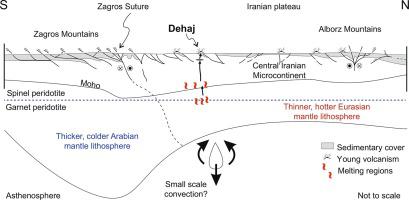当前位置:
X-MOL 学术
›
J. Asian Earth Sci.
›
论文详情
Our official English website, www.x-mol.net, welcomes your feedback! (Note: you will need to create a separate account there.)
Distinct sources for high-K and adakitic magmatism in SE Iran
Journal of Asian Earth Sciences ( IF 3 ) Pub Date : 2020-07-01 , DOI: 10.1016/j.jseaes.2020.104355 Monireh Kheirkhah , Iain Neill , Mark B. Allen , Mohammad H. Emami , Ali Shahraki Ghadimi
Journal of Asian Earth Sciences ( IF 3 ) Pub Date : 2020-07-01 , DOI: 10.1016/j.jseaes.2020.104355 Monireh Kheirkhah , Iain Neill , Mark B. Allen , Mohammad H. Emami , Ali Shahraki Ghadimi

|
Research into Arabia-Eurasia collision zone magmatism in Kerman Province, SE Iran, has largely focused on Late Cenozoic adakitic stocks or domes, with debate around lower crustal or subducted slab origins. Contemporary hawaiite-trachyandesite lava flows have been overlooked. New analyses for domes and lavas from near Dehaj show major and trace element distributions relating to two distinct compositional series. One contains medium-K domes with SiO2 > 60 wt.%, high Sr/Y and La/Yb and generally low MgO, Ni and Cr, showing high-silica adakite affinity. The other series has high-K affinity and includes both lavas and dome samples. The two suites partially mixed in the shallow crust, confirmed by fieldwork and petrography. Isotopically the two suites are indistinguishable, implying a geologically ‘young’ age for the source of the adakites. Given its geochemical signatures and non-relationship with the largely mafic, mantle-derived high-K series, we consider the adakite series to be derived from melting of eclogitized mafic lower crust. The high-K series relates to dehydration melting of mantle peridotite deeper within the ∼220 km thick lithosphere. We also explore adakitic magmas across Iran and their relationship to porphyry copper deposits. At Dehaj and several other Iranian centres, adakites are chemically controlled by garnet as a source or fractionating phase, and are barren, whereas the presence of amphibole as a key phase seems to correlate with Cu mineralisation. This study also shows the need for evidence from multiple datasets to constrain adakite genesis and warns of avoiding sampling bias towards felsic lithologies.
中文翻译:

伊朗东南部高 K 和埃达克质岩浆活动的不同来源
对伊朗东南部克尔曼省的阿拉伯-欧亚大陆碰撞带岩浆作用的研究主要集中在晚新生代埃达克岩群或圆顶,围绕下地壳或俯冲板块起源的争论。当代夏威夷粗安岩熔岩流已被忽视。对 Dehaj 附近的圆顶和熔岩的新分析显示了与两个不同组成系列相关的主要和微量元素分布。一种包含 SiO2 > 60 wt.%、高 Sr/Y 和 La/Yb 以及通常低 MgO、Ni 和 Cr 的中 K 圆顶,显示出高二氧化硅埃达克石亲和力。另一个系列具有高 K 亲和力,包括熔岩和圆顶样品。这两个套件部分混合在浅地壳中,野外工作和岩相学证实了这一点。从同位素上看,这两个套件无法区分,这意味着埃达克岩的来源在地质上属于“年轻”时代。考虑到它的地球化学特征以及与大部分为镁铁质、地幔衍生的高 K 系列的非关系,我们认为埃达克岩系列源自榴辉岩化的镁铁质下地壳的熔融。高 K 系列与约 220 公里厚岩石圈内更深处的地幔橄榄岩的脱水熔融有关。我们还探索了伊朗的埃达克质岩浆及其与斑岩铜矿床的关系。在 Dehaj 和其他几个伊朗中心,埃达克岩受石榴石作为来源或分馏相的化学控制,并且是贫瘠的,而角闪石作为关键相的存在似乎与铜矿化有关。这项研究还表明需要来自多个数据集的证据来限制埃达克岩的成因,并警告避免采样偏向长英质岩性。
更新日期:2020-07-01
中文翻译:

伊朗东南部高 K 和埃达克质岩浆活动的不同来源
对伊朗东南部克尔曼省的阿拉伯-欧亚大陆碰撞带岩浆作用的研究主要集中在晚新生代埃达克岩群或圆顶,围绕下地壳或俯冲板块起源的争论。当代夏威夷粗安岩熔岩流已被忽视。对 Dehaj 附近的圆顶和熔岩的新分析显示了与两个不同组成系列相关的主要和微量元素分布。一种包含 SiO2 > 60 wt.%、高 Sr/Y 和 La/Yb 以及通常低 MgO、Ni 和 Cr 的中 K 圆顶,显示出高二氧化硅埃达克石亲和力。另一个系列具有高 K 亲和力,包括熔岩和圆顶样品。这两个套件部分混合在浅地壳中,野外工作和岩相学证实了这一点。从同位素上看,这两个套件无法区分,这意味着埃达克岩的来源在地质上属于“年轻”时代。考虑到它的地球化学特征以及与大部分为镁铁质、地幔衍生的高 K 系列的非关系,我们认为埃达克岩系列源自榴辉岩化的镁铁质下地壳的熔融。高 K 系列与约 220 公里厚岩石圈内更深处的地幔橄榄岩的脱水熔融有关。我们还探索了伊朗的埃达克质岩浆及其与斑岩铜矿床的关系。在 Dehaj 和其他几个伊朗中心,埃达克岩受石榴石作为来源或分馏相的化学控制,并且是贫瘠的,而角闪石作为关键相的存在似乎与铜矿化有关。这项研究还表明需要来自多个数据集的证据来限制埃达克岩的成因,并警告避免采样偏向长英质岩性。



























 京公网安备 11010802027423号
京公网安备 11010802027423号